In the 1990s, many subcultures and social movements emerged to shake up the status quo. Extreme sports were not an exception. Mountain biking went from fringe to mainstream and from challenging to, at times, insane. Then, as if barreling down mountains on two wheels was not hard enough, the unicycle — a past symbol of circus clowns — began to appear on the world’s most extreme slopes.
Mountain unicycling, also known as muni, slowly but surely gained credibility. Soon, no one was laughing. The UK, United States, Australia and Switzerland began to hold annual events in honor of this odd sport, such as the North American Unicycle Championships. Muni riders claim that it’s more interesting and less complicated than its two-wheeled counterpart, despite the need for more balance, concentration and quick problem-solving.

Lutz Eichholz airing it out on the Matterhorn. Photo: Lutz Eichholz
For the past 10 years, Lutz Eichholz has made a professional career out of unicycling. One of the main faces of the sport, the German daredevil-cum-athlete has taken his wheel on the Mettelhorn (3,406m) and Matterhorn (4,478m) in the Alps, the Andes and the Wadi Rum Desert in Jordan. However, it had long been his dream to ride Iran’s highest peak, Mount Damavand, which rises to a formidable 5,610m.
Many athletes and mountaineers before him have underestimated this active volcano’s silent power. Altitude sickness, as well as the loose and rocky slopes, have deterred mountain bikers. Yet, Eichholz endured the altitude and a close encounter with a noxious sulphur plume to get to the top, which took a day and a half. During the climb, two crew members fell ill with altitude sickness; one broke a leg. Nevertheless, Eichholz pushed on to break a world record in September 2014, riding the highest peak ever done on a unicycle.






